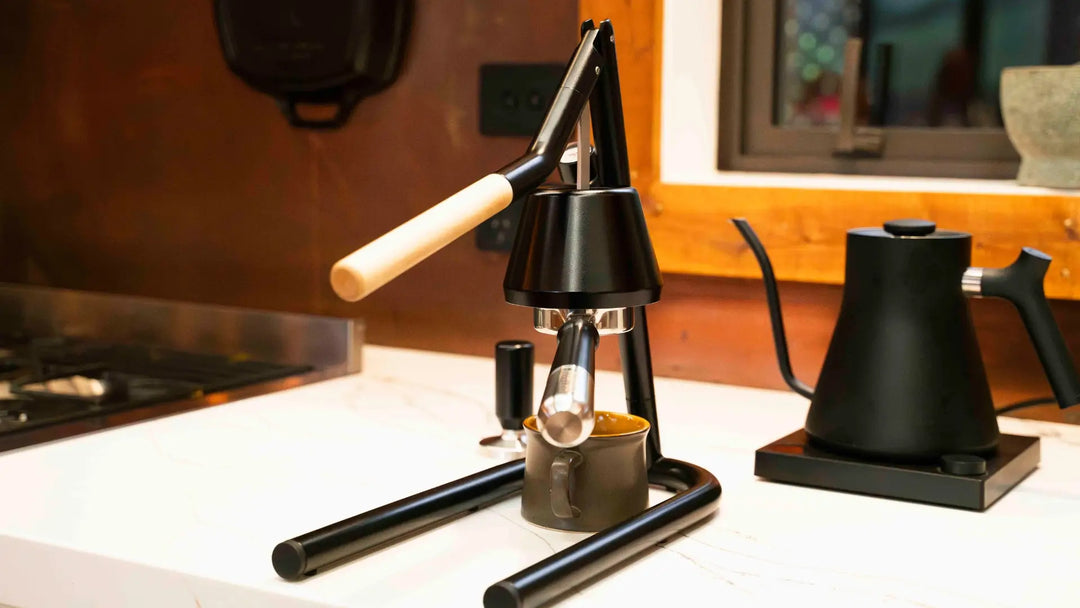Manual Espresso Makers: What to look for
What to look for when buying a lever press manual espresso maker.
First things first, Newton Espresso sells manual espresso makers - specifically manual lever press espresso machines like the Brua3 Max. This means we understand that there can be a slight learning curve for new home baristas, so choosing the right manual espresso maker for you will make a huge difference to your experience.
The following article is our advice for those looking to purchase the best manual espresso maker and we will start by saying:
-
Purchase a manual espresso maker by first understanding why you want to brew manually, and then understanding what to look for.
-
Consider your espresso needs, including your budget and requirements for portability because not all manual espresso makers are portable, and not all portable espresso makers offer pressure control or professional performance when pulling shots.
If by the end of this guide, you realise you don’t want or need the control or simplicity of a manual lever-press espresso maker, then we’ve equally done our job as if you recognise you want one more than ever!
1. Why do you want to buy a manual espresso maker?
There are numerous reasons you might be looking for manual espresso makers to buy.
-
Maybe you’re working from home and want to enjoy quality espresso without sacrificing the bench space required by a much larger automatic coffee machine
-
Perhaps the recent cost increase at your local cafe is no longer sustainable and you need an alternative cafe coffee equivalent
-
Or you might be a seasoned home barista wanting to master another style of espresso brewing
Whatever the reason, we’ve outlined some key considerations below to help you decide if manual espresso is right for you. Keep reading to see where you land on each! With a manual espresso maker, you can achieve surprisingly good espresso, rivalling the quality of far pricier machines.
2. Cost of manual espresso makers
If cost alone is your main motivation, then a lever-press may not be the most suitable option for you. It's a misconception that manual espresso makers are always the cheapest espresso makers. Just quietly, there are plenty of cheaply made automatic espresso machines on the market that might suit your needs perfectly - if you're looking for convenience over quality coffee.
Alternatively, there are also entry-level manual coffee makers available, so if you’re looking for a low-cost manual coffee maker and don’t care too much about product or coffee quality, these could be a great option. Some of these products allow you to use pre-ground coffee which can be a cost-effective and convenient choice for traveling or camping, where using whole beans isn't feasible.
You really need to consider the other reasons you might be looking at buying a manual espresso maker before making a decision. Keep reading and this guide will help.
3. Manual espresso machine size
Do you have limited space in your kitchen or on your brew bar? Perhaps you’re looking for a portable espresso maker to take away in the caravan, to the holiday home, or on the yacht? If so, then maybe a portable espresso machine is a good option for you, but does it need to be a lever machine?
Our advice: consider where you brew and what you want to brew. Many compact coffee makers are perfect when you don’t have the space required for a full espresso machine set-up. Think of those hand-held travel espresso makers that you’ve seen online - could these be the better option for you?
Maybe you’ve seen people demonstrating how to make “genuine espresso” using these tiny, portable devices next to a river, on top of a mountain, in a tent or out at a picnic. Cool right? … but what happens if you also want to develop as a home barista in control of the process? This brings us to the next consideration, brew control.
4. Brewing Control to create the best quality espresso
Brew control allows you to control your brewing process monitored with a pressure gauge. A lever-press espresso maker with an easily viewed pressure gauge gives the user full control. To create pressure, you manually use a lever that acts on a piston to force water through the coffee grounds, producing espresso shots. “Wait, don’t you still have a lot of control with most espresso makers?”, I hear you ask. It’s a “kind of, sort of, yes and no” situation.
A lot of electric espresso machines offer control over many of the variables that go into extracting perfect espresso, but the type of control differs a lot.
With automatic/electric machines, often the user is required to set and execute the brew parameters by briefly turning a knob or pressing a button. This can be a half step too far away from the control many of us like when making coffee.
Manual espresso offers hands-on, real-time control that you can feel (literally) in the palm of your hand. Our advice: consider what type of control is right for you.
5. Espresso maker longevity
It’s no secret that we live in a throwaway culture where products are designed with planned obsolescence built in.
With so many new coffee products being introduced to the market, there’s a mindset that nothing needs to last long, only long enough until the next new thing arrives.
At Newton Espresso, we challenge this mindset. We know that quality products last longer and are more enjoyable to use. We also know the more a product is used and enjoyed, the less likely it is to be replaced and therefore better for the planet!
A key component in ensuring the quality and durability of an espresso maker is the brew head. The brew head plays a crucial role in creating the pressure needed to force water through the coffee grounds and into the cup.
So what does a good quality lever-press coffee machine look like? Start by looking at the materials and processes used in manufacturing.
More considerations when buying a lever press manual espresso maker.
Materials used in the best manual espresso makers
Replaceable seals
Can the seals be replaced if required?
Our advice: Consider how long you’d like your espresso maker to last and how often you intend to use it. If you want 5+ years of daily use, look for something that is easily maintained.
Sustainability
There’s a lot of hype around sustainability in the coffee industry right now. Cafes are encouraging a shift away from single-use cups and roasters are pushing for the fair treatment of coffee farmers. All great things.
Perhaps you (like us) feel pretty strongly about making a conscious effort to look after the planet and leaving it better than we found it.
Just how far you take this within the context of making coffee and shopping for espresso makers depends on your convictions, but often sustainability and fair trade will likely come with a higher price tag.
With regards to espresso makers, not all manual espresso machines will be a perfect option if you are looking for zero waste, zero environmental impact and fair trade.
Often manual coffee makers will still comprise plastic components, volatile production processes and manufacturing worker conditions, excess throwaway packaging, and over complicated distribution and transport journeys. It comes down to the individual company’s philosophy.
At Newton Espresso we actively aim to be as kind as possible to the environment. Some ways we do this include;
-
Using 100% recyclable and sustainable materials (including FSC timber and cardboard packaging)
-
We offer direct-to-consumer shipping minimising our carbon footprint
-
Our quality materials will last at least one lifetime
-
We practice good design. Simple design, without any weak points vulnerable to breakage
- We control our manufacturing process and understand our manufacturing partners by talking to them face to face at their premises
So if sustainability and recyclability are key considerations for you, the best option is to research the environmental stance of the brands and products you like before purchasing anything that will compromise your environmental values.
Espresso maker tactility
Going manual means getting tactile (see the previous “brew control” section).
Consider how hands-on you want your espresso-making process to be. Many people love the feeling of unplugged espresso - “crafting” their brew with their own hands. Not one of them? Then manual espresso probably isn’t for you.
However, if you are one of the many who enjoy a hands-on coffee brewing experience, you will understand that manual espresso is a craft process. The user is the craftsperson and the espresso maker is a tool. Pulling an espresso shot manually allows you to control the pressure and extraction, making it a truly personalised experience. A master craftsperson knows the importance of quality tools.
We understand that a quality espresso maker (or tool) extends beyond the resulting espresso to the machine’s functionality and ease of use. This is why we have designed the Brua3 Max workflow to be as simple as possible - from a safe and very simple preheat to pulling multiple shots in a single session.
So, do you need a manual espresso maker?
Hopefully now you have a better idea if a manual espresso maker is right for you and can understand how manual espresso machines are a great option for enjoying high-quality, uncompromised espresso. These machines are known for producing great espresso with well-balanced shots and good crema.
If you are looking to gain total control over the extraction process, or if you don’t have the budget or space for an automatic/electric espresso machine, a lever-press espresso maker could be the answer!




